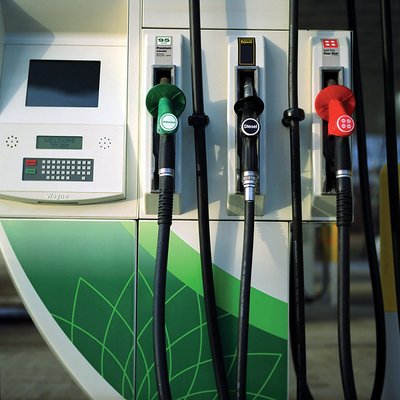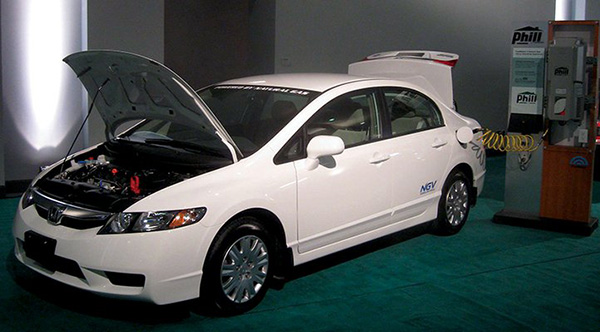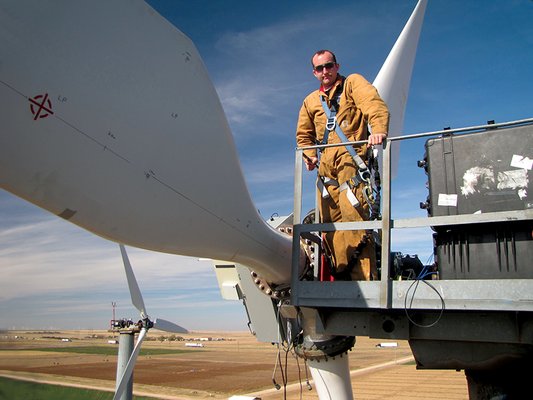
by Michael E. Webber Friday, January 20, 2012

Are hydrogen fuels, natural gas or biofuels the way of the future? BP, p.l.c.

Honda Civic built to run on natural gas, as shown at the 2009 Auto Show in Washington, D.C. IFCAR

Jon White, a doctoral student at Purdue University in Indiana, conducts a field test on a Sandia experimental wind turbine in Bushland, Texas. Mark Rumsey, Sandia, Department of Energy
In the 1985 classic “Back to the Future,” Doc Brown, the mad scientist played by Christopher Lloyd, queries his time-traveling visitor, Marty McFly (Michael J. Fox), in 1955 about the future of America with the simple question of who was president. The answer of Ronald Reagan appeared astounding and ridiculous, as his name was on a movie poster at the time.
Such is the way it is with an innovative and evolving society such as ours: Ideas and concepts that seem ridiculous in one era make sense in another. At the end of the movie, Lloyd returns to 1985 from a more distant future with a coffee grinder-sized “Mr. Fusion Home Energy Reactor,” which he fuels up with trash to provide the 1.21 GigaWatts of power he needs to operate his DeLorean’s time-travel-enabling flux capacitor. With a twist of irony, perhaps the movie’s predictions of handheld nuclear devices will prove to be startlingly accurate. The recent announcement of Hyperion’s hot tub-sized, sealed, distributed nuclear devices that can supply enough power for 20,000 average U.S. households suggests we’re further along that path than one would have expected.
It is within this context that I’ll lay out some of my thoughts about what our future energy systems hold for us. Any good observer of humankind’s relationship with energy would recognize the folly of making predictions about the future of energy.
After all, in the energy world, it is just as easy to make predictions that are correct for all the wrong reasons (for example, because of the odd fortune of including two mistaken assumptions that cancel each other out), as it is to be wrong for all the right reasons.
And thus it is only a fool who would be bold enough to put pen to paper to mark the permanent written record with his or her predictions about energy.
I am that fool. And these are my predictions.
I won’t get into oil very much, as my esteemed colleague has already done that. I will only say this: As society struggles to find ways to displace oil, we will continually bump up against the fact that for transportation, it’s simply the best fuel on the market. That’s hard to compete with and will introduce delays into our energy transition.
At the same time we have two parallel trends: developing societies that want more oil than ever before and the increasing cost of producing oil because of aboveground reasons (developed societies that don’t want oil and are implementing policies that make it more expensive to find, produce and consume petroleum) and belowground reasons (the most accessible oil has already been produced). These countertrends mean that demand for petroleum will stay high at the same time access to its resources will be more expensive. These will combine to push prices higher until the time that an abundant, sustainable and economical alternative fuel finally arrives, likely two to four decades from now, at which time demand for petroleum will plummet and prices will crash. That is, petroleum might follow the path of whale oil, whose prices collapsed when something better — namely petroleum — came along.
Could natural gas be to oil what oil was to whale oil? Maybe. Natural gas prices have been quite low recently, but as a part of a general upward trend in energy prices that we’re going to see, natural gas prices will climb back up, and in the process, the United States will (re)discover its natural gas. Then we’ll see a lot of changes.
The U.S. Congress will discover that natural gas is an abundant, clean, domestic resource, something that apparently slipped its mind during the development of the American Clean Energy and Security Act, which the House passed last summer. It’s as if the entire bill was written about coal and oil, and its authors forgot that natural gas is the primary source for one-fourth of our energy consumption, is mostly produced domestically, has half the carbon footprint of coal (or better, when used with combined cycles), one-third lower carbon emissions than petroleum, and is a part of a domestic resource base that grows with time. For electricity, we can use natural gas to displace coal and to supplement our variable wind and solar resources — in the process improving our air quality, security and economy. Once Congress realizes that we have a lot of natural gas and that natural gas is a great enabler of renewable electricity, many of our energy problems will be solved for at least a few years.
Furthermore, to displace oil, we could use natural gas to power up our cars. In the near future, Americans will discover that natural gas vehicles — already in existence — are cost-competitive with hybrids, plug-in hybrids and diesels. All this talk about electric cars is fun, but is also part of a century-old competition between batteries and gasoline tanks. The dark horse here is that the many tens of millions of households that have garages and natural gas hookups will discover the convenience and cost-effectiveness of filling up their clean-burning natural-gas vehicles at home.
The irony is that our natural gas reserves are only abundant if prices are higher. At low prices, extracting shale gas is uneconomical, but at high prices, we have more than we can handle. And such is the trick of the energy trade: having prices high enough to pull the resource out of the ground, but low enough that people can afford to buy it.
Five years from now, we’ll look back at all the worrying that carbon legislation would ruin the economy and laugh. We worried that U.S. auto companies would be devastated by fuel economy regulations in the 1970s, only to see their resurgence in the years shortly after the rules were put in place. We fretted that cap-and-trade in the 1990s to mitigate acid rain would ruin the economy, only to see the economy grow in the decade after its implementation at the same time sulfur emissions dropped rapidly. The benefits of cap-and-trade outweighed the costs by more than an order of magnitude. And such is the way it will go with carbon legislation.
It’s the fundamental American story. There are thousands of hungry entrepreneurs who are just waiting for the right carbon price signal, at which time they will unleash their inventions and services to bring low-carbon energy to our lives. In the process, they will create jobs, wealth and opportunity. And if you include the subsequent ecological and public health benefits of avoided pollution, the economic value will be even greater. The 1930s saw massive global economic depression — and the minting of many millionaires because of great shifts in the energy industry. This era of economic depression will be no different.
One of the great ironies is that Texas, the primary oil state for the last century, will profit handsomely from carbon legislation. In an era when the world will increase its demand for low-carbon fuels, Texas' abundance of solar, wind and natural gas resources will be a jackpot. Its efficient refineries and independent electric grid provide more opportunities to implement sophisticated market mechanisms and sell low-carbon products than anywhere else in the United States. And its geology gives great opportunity to sequester the world’s carbon — for a profitable tipping fee, no doubt.
In the next few years, many will die and millions will be displaced because of water scarcity and conflict. Africa, India, the Middle East and interior Asia all are likely locations for this dreaded inevitability. We might as well start preparing now by creating ship-based emergency desalination systems and waste- or solar-powered water treatment systems that our military can deploy as an olive branch and a boost to our foreign policy.
In a more concrete prediction for the next year, I’ll argue that 2010 is the year that solar power starts an exponential growth cycle just like wind power did in 2000 — one decade later, but with the same trajectory. The main reason solar will ramp up next year is because it will finally reach grid parity (it will be cost-competitive with other new power plants) in the near future. That’s actually not even really a prediction, as solar is already at grid parity in some places during peak times.
The biggest breakthrough will be that in the next five years, we will once and for all break the intellectual logjam where we pretend we have to choose between the economy and the environment. Instead, we’ll choose both.
© 2008-2021. All rights reserved. Any copying, redistribution or retransmission of any of the contents of this service without the expressed written permission of the American Geosciences Institute is expressly prohibited. Click here for all copyright requests.